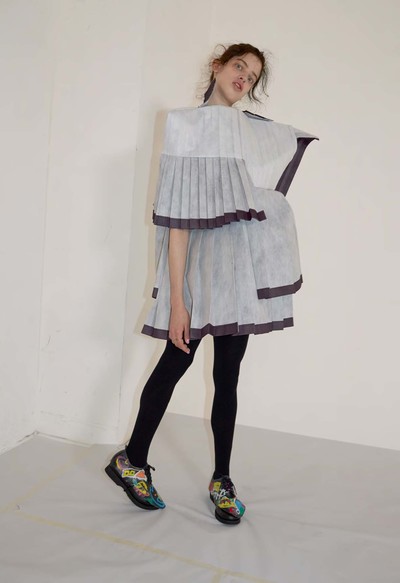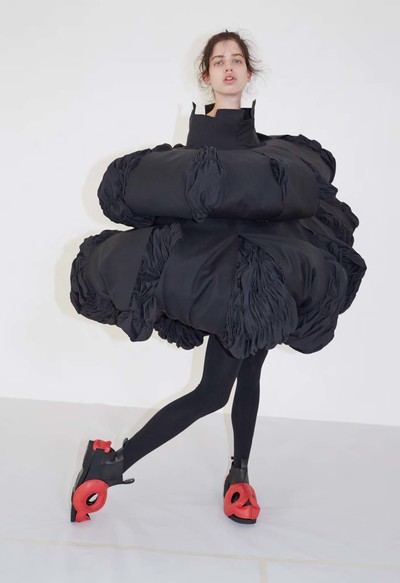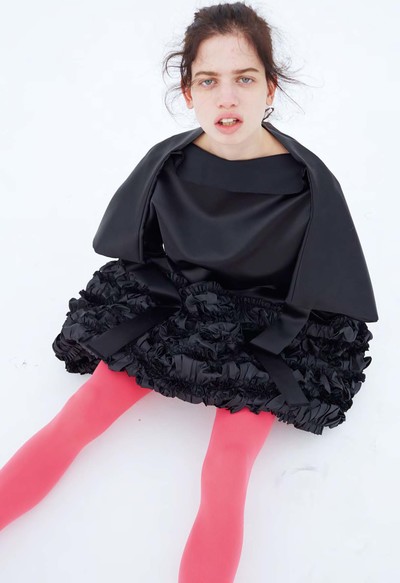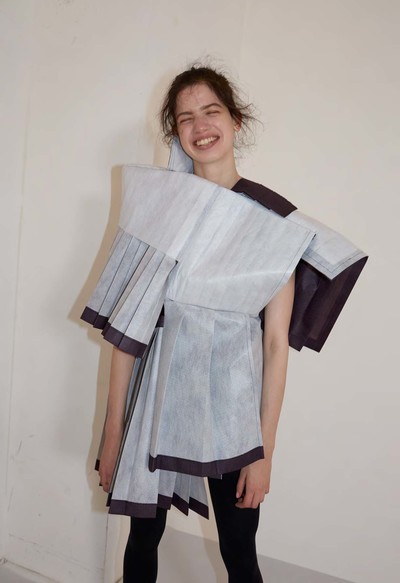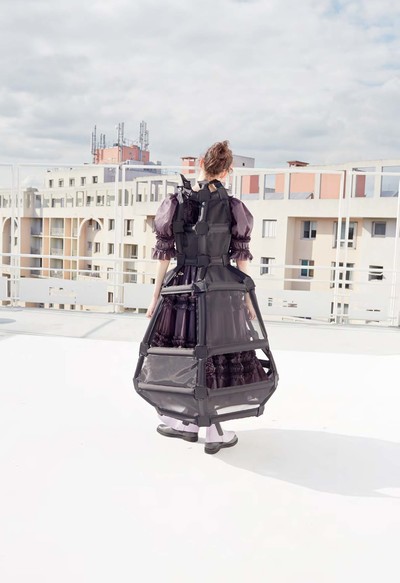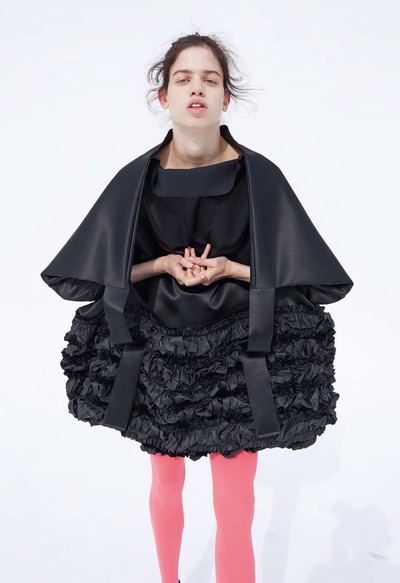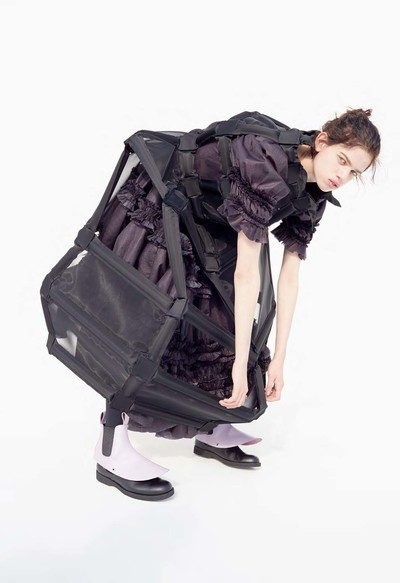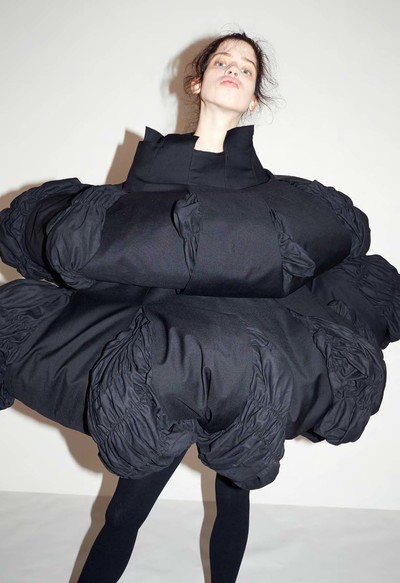Rei Kawakubo’s quiet revolution just got louder.
By Hans Ulrich Obrist
Illustration by François Berthoud
Photographs by Juergen Teller
Rei Kawakubo’s quiet revolution just got louder.
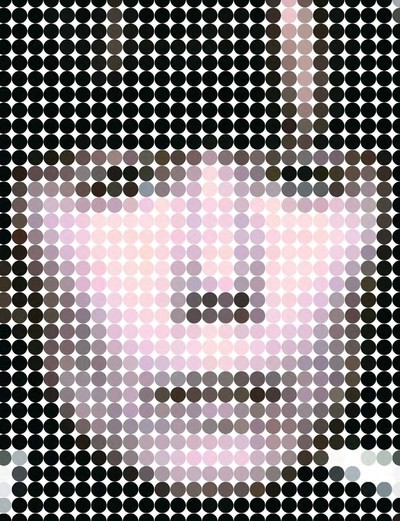
Going around museums and galleries, seeing films, talking to people, seeing new shops, looking at silly magazines, taking an interest in the activities of people in the street, looking at art, travelling: all these things are not useful, all these things do not help me, do not give me any direct stimulation to help my search for something new. And neither does fashion history. The reason for that is that all these things above already exist.
I only can wait for the chance for something completely new to be born within myself.
The way I go about looking for this from within is to start with a provisional ‘theme’. I make an abstract image in my head. I think paradoxically (oppositely) about patterns I have used before. I put parts of patterns where they don’t usually go. I break the idea of ‘clothes’. I think about using for everything what one would normally use for one thing. Give myself limitations. I pursue a situation where I am not free.
I think about a world of only the tiniest narrowest possibilities. I close myself. I think that everything about the way of making clothes hitherto is no good. This is the rule I always give myself: that nothing new can come from a situation that involves being free or that doesn’t involve suffering.
In order to make this SS14 collection, I wanted to change the usual route within my head. I tried to look at everything I look at in a different way. I thought a way to do this was to start out with the intention of not even trying to make clothes. I tried to think and feel and see as if I wasn’t making clothes.
Rei Kawakubo, October 2013
For a house that’s gleefully operated on the margins of the fashion industry for 40 years, Comme des Garçons’ Spring/Summer 2014 collection was unconventional – even by Rei Kawakubo’s standards. Commenting backstage, the 71-year-old Japanese designer referred to the 23 looks as ‘anything but clothes’. She wasn’t lying. To label these sculptural objets mere clothes would be to align them with the many hundreds of collections the fashion industry spews out each season. For them not to be different would have meant Kawakubo had failed. The rapturous applause at the end of the show proved otherwise.
Since showing her first collection in Paris in 1981, the industry’s press and buyers have become accustomed to Kawakubo’s regular and radical expressions of sheer otherness. Nothing, how- ever, can prepare you for what’s next. That’s the whole point.
From ‘body-bump’ dresses (‘Body Meets Dress, Dress Meets Body’, Spring/Summer 1997) to mummified wedding gowns (‘White Drama’, Spring/Summer 2012), it comes as no surprise to discover Kawakubo is driven by a wanton – even stubborn – desire to create something new, something that further pushes the boundaries of what can be accepted as fashion.
Some of her premonitions have since become industry standards (guerrilla stores, artist collaborations…), while others (the tarmac, kerosene and smoke scented anti-fragrance), it’s safe to say, probably never will.
The voice of the designer has never been so important in disseminating brand values. Cynically put, he (or she) who shouts the loudest, gets heard the most. Yet whilst Kawakubo’s refusal to explain herself has often frustrat- ed her public, her silence has given her voice more power and resonance than any fashion designer in the industry today.
The following conversation took place on Sunday, 29th September, between Hans Ulrich Obrist – himself an eminent curator and commentator operating in the art world – and Rei Kawakubo. The designer’s husband and Comme des Garçons CEO Adrian Joffe acted as interpreter. The conversation then continued over a series of email exchanges, culminating in Rei Kawakubo’s beautifully articulate statement that you can read on the previous page.
Hans Ulrich Obrist: Hello, it’s a real honour to meet you. I’d like to start right away with my first question.
Adrian Joffe: Rei’s not a typical designer who is able to answer questions in an easy way. [To Rei] Hans sometimes interviews artists like Gerhard Richter.
I have a very nice story to start with. Many years ago, I went to see the great philosopher Hans-Georg Gadamer – he was a student of Heidegger, Germany’s oldest and most legendary philosopher. At a certain moment during the interview, Gadamer fell asleep. After 15 minutes, the telephone rang – he picked it up and realised what had happened. The tape recorder was still running, so he looked at me and said, ‘You will have great problems in transcribing my silence.’
For the last four or five years, I’ve been working on Metabolism; I don’t know if you know the book that Rem Koolhaas and I made on Metabolism and Metabolist architects, Kikutake, Maki and Kurokawa? [Project Japan. Metabolism Talks… by Rem Koolhaas and Hans Ulrich Obrist is published by Taschen.] It was an amazing period of time in Japan; there was experimental music, Gutai, Metabolism… You started in the late 1960s in this environment, and I was wondering how that environment inspired you?
Rei thinks there’s no relation. She started her career in 1969.
What inspired you when you first started? Did you have any heroes or inspirations?
Everybody has… Rei wanted to start working. It was the beginning of her career, and she decided to create her company, Comme des Garçons. There were no particular heroes or influences. She just wanted to make her own living. For her, it was just that she started working.
‘This is the rule I always give myself: that nothing new can come from a situation that involves being free or that doesn’t involve suffering.’
But was there sort of an epiphany? The other day, I was with a dear friend of mine, Kazuyo Sejima – we’ve made a lot of projects together. She was telling me that when she was a little girl, she saw a little photo of Sky House by Kikutake in a magazine at her family home. She cited that as a kind of epiphany: ‘I want to become an architect.’ I was wondering whether you had a similar experience or trigger?
That totally does not exist for her. She wishes she had a story like that, but she doesn’t.
It just started somewhere?
It just started. It was only because she wanted to work and be independent and make a living.
To be free.
Yes, to be free. There was a little lack of experience of growing up. You know the story right? She was a stylist at a magazine; she couldn’t find anything that she liked to photograph, so instead she decided to make it herself which is when she created her own company. There was no epiphany. She wishes she had one for you, but she doesn’t.
I was curious because artists in my field, in the art field, usually have a catalogue raisonné, a comprehensive catalogue of all their work – including their earliest student works. It’s usually in this first artwork they find their own language. Which would you say was the work, piece or dress where you found your language?
It started with what she calls kachikan (which means a sense of values in Japanese) – which is what we call the language of Comme des Garçons. There wasn’t one point. As people grow and develop – the language grows and develops. It started with one language, and just like any ningen (human being in Japanese), it grew and evolved at each stage. She thinks this is probably the same with everybody. She doesn’t think she’s special in having a language that developed along the way.
It becomes more complex.
Sometimes it becomes more simple.
When you were saying that there was no epiphany, it sounded like it could have been an accident. In a previous interview, you said that there was a feeling of synergy and accident. That’s interesting because it sounds a lot like John Cage and also the idea of embracing chance. I was curious about whether you could talk a little bit about that.
She said an accident is not something you preview, it’s just something that happens. It’s a matter of being open to it. It’s not something that you can plan. She doesn’t know how to elucidate.
Was music important to you? Or John Cage?
Nothing for her. She doesn’t know these people. She knows who John Cage is, but she doesn’t know anything about him. She knows a little bit about him from when she worked with Merce Cunningham.
‘They’re a burden. I have no desire for possessions… I’ve never wanted to collect anything for as long as I can remember.’
That’s obviously what interests me the most, the collaborations with artists and the art world. How did that start? Who was the first artist that you collaborated with?
She thinks that began when she created Six magazine in the early 1980s. The idea was to communicate the values of Comme des Garçons through Six, and that was the point where she started to collaborate with various artists. Do you remember Six?
Yes, of course. I love Six. Could you give a few examples of artists that you have been particularly fond of collaborating with?
It’s not a case of liking, it’s a matter of the end result of the work being good.
Recently, it was the photographer René Burri, my compatriot because I’m also Swiss. What attracted you to Burri? He’s obviously a great Magnum photographer…
What was the experience like?
Yes. What inspired you about him? He wrote a beautiful text about the collaboration, so I was curious.
Each year we work with one artist. That year we wanted to work with a photographer and she just… [To Rei] Can you remember? There was a choice of two photographers, René and one more person. She says she told René this and he didn’t mind – he knew the other photographer, and he lived nearby to René. [To Rei] What’s his name? They were her two favourite photographers. They met and got on. He sent her all his books, but of course she knew his work well.
Do you collect books?
No. She doesn’t collect anything.
I met Azzedine Alaïa, and he has a whole hanger – it’s giant – full of stuff! It has his own archive but also the archives of other designers, books, art, objects. Do you have an archive?
No, she says she doesn’t like anything like that.
No possessions?
For her, they’re a burden. She says she has no desire for possessions. She doesn’t know why, but she’s never wanted to collect anything for as long as she can remember.
Last month I saw the Met exhibition in New York about punk – punk attitude and aesthetics. I was wondering if you saw it, and how you connect with punk – both now and before? Do you feel comfortable with this notion or label?
She likes the punk spirit. She’s always liked the spirit in the sense that it’s against the run of the mill, the normal way of doing things. That’s why she’s always felt an affinity with the punk spirit. She likes that word. Every collection is that. Punk is against flattery, and that’s what she likes about punk.
So, is it a form of resistance?
Yes, it could be taken like that. Against the flattery, against the normal.
There’s an artist who says we can only understand someone if we know what kind of music he or she is listening to. What kind of music do you listen to?
No music.
Silence.
Nothing in particular. All or nothing. What she likes to listen to when she has the choice to listen to something is jazz. She’s never said that to me before.
What about dreams? What is your dream of happiness?
She says she doesn’t need dreams.
How interesting. A few years ago I spent quite a lot of time with Kazuo Ohno – the dancer – I don’t know if you knew him?
No.
He was a famous Butoh dancer – he died at 103 years old. I interviewed him, and he didn’t say much except a few very wild things. He never stopped dancing until he was 101 years old. Do you see yourself working in fashion for the rest of your life – even if you get to 100 years old like Kazuo Ohno?
She thinks that work is a life thing though she doesn’t know what that work will be. Work is work. She can’t imagine retiring.
You once said that you wanted to wake people up…
If people don’t wake up there can be nothing new, and therefore there can be no progress.
‘I’ve always felt an affinity with the punk spirit. I like that word. Every collection is that. Punk is against flattery, and that’s what I like about it.’
One thing that stands out for me in almost all the interviews I’ve read with you is this idea of the new. It’s never about repeating but always finding something new. That’s very much like that Gerhard Richter does with painting. He finds new rules for the game. This obviously becomes increasingly difficult. Already, when I was a student in the 1980s – there was this feeling with the 1980s postmodernism that every- thing had been done, that everything was a quote. Rei, you have masterfully always created these new collections. Is there a recipe for how you manage to succeed so successfully and in such an incredible way to create the new?
She’d like to ask you what the recipe is because she struggles every time to find something new. She will not say how she finds something new, but if you have a recipe for how, please tell her, she’d like to know it.
No, I have never found any one recipe – insomnia? I don’t know if that’s good advice.
She’s going to think about that. Maybe she won’t sleep for the next collection.
I wanted to know about the new collection – its full of amazing master- pieces. It’s so architectural, like buildings. I was so impressed by it, so many congratulations. It’s almost like architecture. I was wondering if there was a link and whether you would agree with that?
For this collection, her starting point was not wanting to make clothes. If you say it’s architecture, it could be the right thing to say, because it’s not clothes. As you said, it gets harder and harder to create something new. She says she struggles every time, you can imagine the hell she goes through. If it’s taken as anything but clothes, then you know.
I read the manifesto for the guerrilla stores – they’re almost like rules of the game. Do you have rules?
There are different rules each time, but each time there has to be a rule so that she can react with the rules to find something new.
Can you tell me what the rule for the Autumn/Winter 2012 ‘Flat Collection’ was? That collection has been so influential, and many artists in my field have mentioned that they were inspired by it. It’s also reverberated through all the fashion collections and into art.
For that collection, the rule was to ignore the human body. The human body is three-dimensional, so she worked totally on the flat two-dimensional plane to try to find something new which ignored the body.
So, it’s going from the 3-D to 2-D. What would you say are some other rules which you have used that were particularly memorable? Many people with whom I’ve talked – artists, designers, architects – have mentioned the ‘Bump Dress’, which was a great invention. What was the rule of the game there? What prompted the ‘Bump Dress’?
At that point, the rule was that she thought she couldn’t do new clothes, so she did new bodies. In order to make new clothes she made bodies. Not new bodies, but body shapes.
You formed them.
She formed the body shapes. And then put the thing around it, and that became the clothes.
That’s so sculptural.
Don’t design clothes, design bodies.
Can you give some other examples? I’m very fascinated with rules of the game. How about the 1981 ‘Lace Collection’?
Of course, every time there is one. She said she can’t think of another particular example now but that the way of finding that thing each time is almost to bully herself, to give herself constraints and regulations. There is always one rule, the kachikan of Comme des Garçons and then there are themes, subthemes and interlinking plots.
That’s so fascinating. There’s an entire French literary movement which began in the 1960s called Oulipo – the most famous man from that movement was Georges Perec, and he said the same thing about poetry. He said that we can only create poetry if we set very strong, even brutal constraints.
The same.
He wrote an entire novel without the letter ‘e’! I wonder if this idea of constraints also applies to your other inventions like scents, for example Odeur 53?
Rei says that making perfume is nothing like making a collection. With every perfume, she makes something new – a new smell, new ingredients, new ideas for packaging. With Odeur 53, we just had the idea to make an ‘anti-perfume’ with no natural ingredients, just with smells from daily life recreated by headspace technology in a very large commercial 200 ml bottle.
It took a long time between the invention of television and the creation of great art with television. It’s not immediate. It’s similar with the internet – the creation of the internet has not yet meant that great art or fashion has been created with it. I’m interested by your choice to not use the internet for a long time. Has the internet changed your working practice in anyway?
Something about internet is very different to the human mind. The human element is missing between fashion creation and the internet. That’s why she’s not interested in it. She thinks it can’t be translated. She doesn’t know whether it will take time before it happens, but at the moment she doesn’t think it’s happening or if it will ever happen.
‘The human element is missing between fashion creation and the internet. That’s why I’m not interested in it. I think it can’t be translated.’
The human connection is missing. Many of my friends in art and architecture are concerned that writing and drawing are disappearing. I read in books that text and drawing don’t play a big role anymore, what do you think of this? What role do writing and drawing play in your working practice?
She doesn’t draw.
Do you write? Or is it all spoken?
If anything, it’s with words. Or, a word.
Written and spoken?
Yes.
So, are the rules written down?
The rules are not written down. The rules are in her head. She doesn’t write them down.
John Waters has of course written a lot about you. So when I was preparing for this interview, I revisited his notes, and he told me that travelling may be your most important inspiration – not collecting, art, literature, music but travelling. Could you talk a little about travel and how that influences your work? Was the recent collection inspired by a trip?
She’s afraid to say there’s no connection. She hasn’t travelled for about four years. She visited Romania and Yemen ten years ago. Recently there hasn’t been much travel, and even if she travels, she says it’s just as difficult to find something else. You can’t get away from yourself.
So, there were no trips.
No, no trips. She’s been too busy: too much work. It’s inside her.
How does a normal day look?
It’s just constant work. She gets there early, stays late and just works. She also runs the company. She helps design the space. She does everything. She checks every single detail about everything for the company. So every day is taken up from morning to night with details, thought and work.
But that’s important. In art, one talks about the Gesamtkunstwerk, the total work of art: the artist does everything. I’m fascinated by that. I have the feeling that with you, it’s similar – every piece of paper, every item of stationery, every advertisement…
Advertising, interiors, decoration – everything.
So, there’s no hierarchy in that? Can one say that everything is important?
As you said, it’s a very difficult task, but she says it’s the only way she knows how to work. It’s very hard to have a hierarchy because for her everything is important; she sees and controls the running of the visual creation of the company in every way.
And that all comes out of your mind – out of your ideas? I was curious to see how political and historical events have entered that process; you say it all comes from the inside, but how have you been affected by external events – like Fukushima or other big historic events in the world. Have they had an impact or not?
She’s not unaffected by events. It’s strange in a way that nothing is directly influenced. It’s like everything and nothing. Nothing directly but maybe many things indirectly in society, things that she has opinions and feelings about, political issues and things like that, but nothing is really connected to the work.
Earlier we spoke about Six magazine. What prompted the idea of doing a magazine, and is it something you’re still interested in?
She wanted to express and communicate the values of the company in a different, subsidiary way, not only through clothes. That’s how it started. Since then, there have been other means but it may return.
‘I haven’t travelled for about four years. Even if I travel, it’s just as difficult to find something else. You can’t get away from yourself.’
Different magazines?
Different magazines, like the yearly thing that comes out now.
And what’s down the road? The stores are also part of the Gesamtkunstwerk. John Waters writes that the ‘shops are like a medium designed by Rei…’ He mentions the West 2nd St boutique, but I go to Dover Street Market in London all the time – I’m very passionate about Dover Street Market. I think it’s the best shop in London. It’s also an extension of what you do.
That’s a very important part of communicating our values. She does all the stores.
And what’s the idea with these guerrilla stores? That’s something which is very common now.
We stopped doing them now because everyone is doing them.
Yes I know, but you anticipated them. How did the idea come about?
Even in business, we need to find creative ways to do business. This was almost like a no-brainer. We had the stock, and we had these spaces with students who had nothing to do with fashion but wanted to work. So we moved the stock from our warehouse to those spaces. It was just a business idea to do business in a new way.
And if you look at…
The rules are the rules.
Again the rules! Dover Street Market deconstructs the department store; What’s next? Have you got anything else that’s going to push the envelope because you always push the envelope…
If you have a good idea, please tell us because we’re still doing Dover Street; we’re opening in New York in December.
Every city should have a Dover Street.
I don’t think so. Some cities lend themselves.
Every big city.
I don’t think Paris deserves a Dover Street.
Why?
It’s too bourgeois. We did London first because Rei has always felt that energy in London.
What is your favourite city?
She says that there is no one in particular.
I have a question about unrealised projects. It’s amazing when I look at your work, at all the projects that have been realised – these thousands of designs and shows. I was wondering whether you have any projects that are unrealised that are maybe too big or too small to be realised. Are there any dreams or unbuilt utopias by Rei Kawakubo?
There’s no one particular thing.
So there’s no unrealised project?
She says there’s not an unrealised project as yet. As soon as it comes, it will be realised. There is nothing on the back burner.
‘She does everything. She checks every single detail about everything. Everyday is taken up from morning to night with details, thought and work.’
I’ve got some questions from Nick Relph, an English artist who lives in New York, who is a very big fan which he sent me last night. He said that you’re unable to divorce your roles as a designer from that as a business woman. Fashion only occurs in the actual wearing of a garment. What, if anything, do institutional exhibitions of your work mean when both imperatives of dressing and selling are gone? In an exhibition, there isn’t selling or dressing – so that leads us to the question that we are obviously very interested in in the art world: what is the role of the exhibition for you?
She says she never does it because she wants to, but it’s people who ask her to do it.
That’s a good, interesting answer. These exhibitions are not really your thing?
She likes the idea of a three-dimensional exhibition: something that moves, explains and expresses the work. She would like very much to do a 3-D exhibition where the creations, the fashion is moving.
So here we go, that’s an unrealised project!
There we go. You found it. She’s mentioned this to her staff, and they think it’s impossible to work out.
It’s not impossible at all! For example, Pierre Reed had an exhibition that I curated years ago where the dolls move through the space. So it can be done.
It can be done. So maybe you’ll have to do it.
Rei, you play and confuse gender codes in both your men’s and women’s clothing. But is it true that Comme des Garçons staff can only wear collections associated with their gender?
No, that’s not true at all. People are free to buy and wear what they want. There are no rules. She never tells people how to wear, what to wear, why to wear.
People do whatever they want.
Whatever they want; and they do.
So you only give the rules to yourself, and no one else? Is that correct?
Exactly.
That’s so fascinating. I love that idea of not giving rules to others.
There are a lot of men in Japan who wear the women’s collection.
And vice versa?
Not so much vice versa. She said it doesn’t happen as much, but some women are big, so they buy men’s clothes. Men buy women’s clothing for different reasons than some women buy men’s clothing.
That’s a wonderful answer. And the next question from Nick Relph is what are your memories about visiting Seditionaries on the King’s Road?
She can’t remember. She remembers going to Sex.
There was also a collaboration with Vivienne Westwood.
Yes. We sent her the fabrics, and Rei picked out designs she liked then Vivienne made them in our fabric.
I know I can’t ask all the questions I have because I have too many, but there is this idea of collaboration which seems to play a big role in your work and extends to other designers throughout the company.
That’s not a collaboration. That’s business. Watanabe, Kurihara, Ninomiya and Ganryu are a means to grow the company. They’re staff, so I wouldn’t call it a collaboration.
But what you did with Vivienne Westwood…
That’s collaboration.
And the collaborations with the other artists?
The reason for that lies in accidental synergy: 1 + 1 = 3
I think 1 + 1 = 11. That actually leads us to Nick’s last question: Do numbers affect you?
She likes 1, 3, 5, 7, 9. She doesn’t like even numbers.
So, your favourite numbers are odd numbers.
Yes, definitely. You never see anything in pairs.
Also your favourite colour is black, right? In an interview you once did, you said that maybe it’s a time for a new black, because everything is black.
That was a long time ago.
But do you think there is a new black?
It’s not exactly her favourite colour. It’s just the colour she feels is the strongest. It has nothing to do with whether she likes it or not, but she just feels that black is the strongest colour.
For John Waters, it’s about mourning; in the West that’s the association, but obviously that’s too reductive.
No. He’s a great guy, but most of those things are too reductive.
‘It’s not my favourite colour. It has nothing to do with whether I like it or not, but I just feel that black is the strongest colour.’
So, it’s the strongest colour.
She feels it’s the strongest colour.
And what do you think would be the second strongest?
None.
It’s black, and that’s it. I’ve taken up all our time now, but I usually publish a handwritten sentence by each artist I interview as a protest against the disappearance of handwriting. Could you write a sentence for me?
In Japanese?
Yes, that would be great.
She says this isn’t related to her. She doesn’t feel the connection of why she would need to write anything. It’s not related to Comme des Garçons but to something else: it’s connected with your worry about the disappearance of hand- writing. She doesn’t see the need for it.
Or, you could just write Comme des Garçons… I understand, no problem. Thank you so much.
She expects that none of this was very useful to you.
